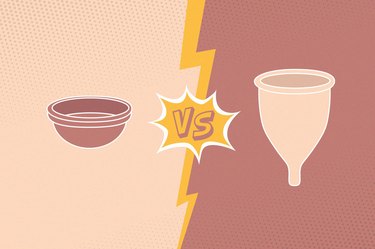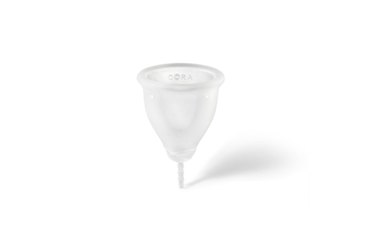
Period products have (thankfully) come a long way — gone are the days when your only options were disposable pads or tampons. That's why you may be weighing the pros and cons of a menstrual disc vs. cup.
After all, both are becoming more popular as alternatives to traditional pads and tampons, and for good reason. They're more eco-friendly, convenient and more cost-effective over time than disposable products.
Video of the Day
Video of the Day
Here's what you need to know if you're deciding between a menstrual disc vs. cup for your period needs.
What Is a Menstrual Disc?
Menstrual discs are a little newer on the period product scene — they emerged in 2015, per the University of Texas at Austin.
A menstrual disc is a disc-shaped receptacle made of medical-grade polymer that warms up inside the body and molds to your shape in order to collect blood. It sits at the base of your cervix, rather than inside the vaginal canal like a tampon.
These discs often come in disposable versions, like the Flex Disc (Flexfits.com, $9.99-$13.99), which features a ring and a clear, malleable, bag-like component where blood collects as you wear it.
There are also some reusable options made from silicone, like the Ziggy Cup (Intimina.com, $31.96).
How to Insert a Flex Disc
Using a menstrual disc can seem intimidating at first, but Flex disc insertion (or inserting other discs), doesn't have to be scary. Here's how to do it, according to the Flex website:
- Step 1: Pinch the disc in half.
- Step 2: Breathe and get into a comfortable position, like sitting on a toilet or standing with one leg resting on a surface.
- Step 3: Use your thumb and forefinger to push the pinched disc into your vagina, angling it down and back toward your tailbone. Then tuck the front rim of the disc up behind your pubic bone.
- Step 4: To remove, wash your hands and relax your pelvic floor muscles by taking a deep breath. Then sit, squat or stand with one leg resting on a surface, hook your finger under the rim of the disc and slowly pull it out.
What Is a Menstrual Cup?
A menstrual cup is a reusable, flexible, cup-like receptacle made of medical-grade silicone (and sometimes rubber) that's inserted into the vagina to collect period blood (unlike tampons or pads, which absorb blood), according to the Cleveland Clinic.
The first patent for a menstrual cup design dates back to 1867, and the early model was a rubber sack attached to a ring, per the Cleveland Clinic. The first commercial menstrual cup was developed in 1937 and they were on the market in the 1950s and 1960s, but these products didn't see much of a boom until the late 1980s.
Today, menstrual cups like the ones from Cora (Cora.com, $39) and Saalt (Saalt.com, $29) can last for up to 10 years with proper care.
How to Insert a Menstrual Cup
Here's how to use a menstrual cup, per the University of Texas at Austin:
- Step 1: Fold the cup in half and pinch it between your fingers.
- Step 2: Insert the cup into your vagina and release.
- Step 3: Rotate the cup 360 degrees to ensure the seal between the rim of the cup and the vagina is secure.
- Step 4: To remove, pinch to release the seal and pull out the cup.
Menstrual Cup vs. Disc
Both menstrual cups and discs have their benefits and drawbacks, and which one you choose largely boils down to personal preference. When making your decision, consider the heaviness of your period flow, your daily activities and how often you want to have to change your cup or disc.
Menstrual Cup Pros and Cons
One good thing about menstrual cups is that they're reusable, which makes them cheaper in the long run, says ob-gyn Kim Langdon, MD.
Per the Cleveland Clinic, some additional advantages of menstrual cups include:
- Less odor, because fluid doesn't get exposed to the air
- Can be worn for up to 12 hours before having to empty it (compared to a maximum of eight hours for tampons)
- Come in a variety of sizes and models
But removing them can sometimes be tricky. "There's a learning curve in the insertion and removal process, and the suction effect makes removal harder sometimes," Dr. Langdon says.
Other disadvantages include:
- Emptying your menstrual cup can be a little messy, especially in a public restroom
- Insertion may be difficult for younger people who are just beginning to menstruate
- Menstrual cups may disrupt intrauterine device placement
- Fit problems are possible if you have a dropped uterus or uterine prolapse
- Regular sterilization using boiling water is required
Menstrual Disc Pros and Cons
The advantages of wearing a menstrual disc over a cup include:
- They can be worn during sex, Dr. Langdon says.
- They may be more comfortable than cups while exercising, per the University of Texas at Austin.
As for the cons:
- They may be harder to remove, Dr. Langdon says.
- They are more expensive than cups over time because you have to buy them more often (although a reusable option offers a more cost-effective solution).
The Bottom Line
Whether you choose a menstrual disc or cup is really all about personal preference. If you are looking for a variety of size and style options and want something that will last for a long time, then the cup may be right for you.
But if you want to eliminate decision fatigue and go with an option that you can wear during sex, then the disc is a great option.
Is this an emergency? If you are experiencing serious medical symptoms, please see the National Library of Medicine’s list of signs you need emergency medical attention or call 911.





